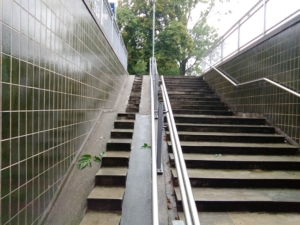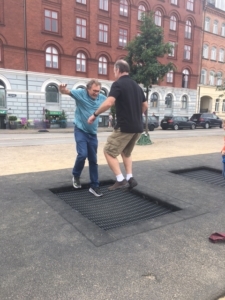By Eddie Pipkin
July 28, 2017
Downspouts and drains have been on my mind a lot lately. I had a longstanding issue with water runoff at my house that I decided to tackle earlier this summer. During our central Florida downpours (sometimes two inches of rain in an hour), the water was not going where I wanted it to go. It ran off the roof and made trenches beside the house. It flowed down the hill uncontrollably, eroding the topsoil and carving the beginnings of a creek bed. So, I had some long-needed gutters installed, which worked beautifully, except I still had the problem of what happened when the water came out of the downspouts in a torrent. And that’s how I became a do-it-yourself expert on French drains and water diversion. A French drain (in case you are not, yourself, a drainage expert) channels the water underground, where it can drain slowly from the pipe through holes into the soil, and if there is a very large flow of water, that water can exit out the other end of the pipe into a better spot in the yard.
Water has its own ideas about where to go. It can be beautiful, or it can be destructive. This depends largely on our ability to understand the natural forces acting on it and channeling those forces in the proper direction. Water is quite excited to move in a purposeful and beautiful manner when given clear direction. So are people!
We ministry leaders like to complain about people and their tendency to head places we wish they wouldn’t go (sometimes even destructively). We have one mental image of how people will engage with our ministry and what our ministry objectives are, only to often be surprised about the actual trajectory taken by those people. It is a common theme in ministry meetings: Why won’t people go the direction we need for them to go?
One of the common reasons that our expectations don’t match outcomes in the real world is that we do not give clear direction. We don’t give people an obvious path to follow, and we don’t express our expectations for them clearly and accessibly. If we, instead, do these fundamental things with consistency, people are far more likely to end in a place that we originally envisioned.
All these ideas of engineered drainage and clearly guided expectations were swirling in my head as I toured Copenhagen, Denmark. The beautiful old city of Denmark is crisscrossed with cobblestone  plazas, sidewalks, and roadways. Cobblestone everywhere! And the thing that fascinated me, having just completed my self-taught water drainage course, was how every cobblestoned surface included subtle but intricate channels for sending rainwater to the storm drains. Every tightly packed stone building had lovely metal gutters and carefully crafted downspouts. The more I looked, the more I marveled at the planning that went into these systems. The very practical issue of water drainage can have both functional and beautiful outcomes (here’s a Pinterest page featuring creatively designed drainage options, and here is a blog about a recent Danish Architecture Center exhibit about this very topic and its increasing importance in a world facing climate change).
plazas, sidewalks, and roadways. Cobblestone everywhere! And the thing that fascinated me, having just completed my self-taught water drainage course, was how every cobblestoned surface included subtle but intricate channels for sending rainwater to the storm drains. Every tightly packed stone building had lovely metal gutters and carefully crafted downspouts. The more I looked, the more I marveled at the planning that went into these systems. The very practical issue of water drainage can have both functional and beautiful outcomes (here’s a Pinterest page featuring creatively designed drainage options, and here is a blog about a recent Danish Architecture Center exhibit about this very topic and its increasing importance in a world facing climate change).
How often do we, as ministry leaders, take the time to “engineer” our processes this thoughtfully? How good are we at channeling the gifts, energy, and passion of the people who have entrusted us with leadership?
Here are some questions worthy of thought:
- When people begin a process with us (say, for example, growing in their biblical knowledge or starting down the path to figuring out how they are called to serve), do we provide them with a clearly navigable pathway of progress? Do they know where they are going, and are the signposts along the way clearly marked?
- Do we clearly and effectively communicate our expectations about their participation in our ministry? Do they understand their roles and responsibilities? Do they have an effective means to review this information?
- Do we as leaders understand the intricate ways in which our ministries (and the ways in which people flow through them) interact with other ministries? Do we cooperate effectively on our “engineering” plans?
- Do we sincerely strive to understand the “gravitational” forces that impact the lives of people as they flow through our ministries, programs, and activities? Do we cultivate a sense of the logistical pressures that people face in their lives that impact how they participate (or choose not to participate) with us?
- Even as we design systems and processes and ministry structures, do we do this in ways that are beautiful? A one-page printout of bullet-pointed ministry expectations is less beautiful that a welcome luncheon for ministry volunteers at which they are celebrated and given a chance to interact.
Not only have the leaders of Copenhagen given lots of thought to how to help water find a worthwhile path, they’ve cast visions of how they hope people conduct themselves in the city. And not only have they come to a consensus about what the city should  look like and how it should function, but they have also funded an infrastructure that supports that vision. Here are two examples:
look like and how it should function, but they have also funded an infrastructure that supports that vision. Here are two examples:
- Copenhagen is one of the most bike friendly cities on the planet. This is the result of a cohesive vision for cutting down on pollution and traffic congestion in the city center, while also including people to make healthy choices. It is very easy to commute by bike in the city, which has extensive bike lanes, clear bike traffic signals, plenty of bikes available for cheap rental, and (as evidenced by the picture) wide rails for rolling bikes easily up and down the stairs to the subway.
- Copenhagen wants to be a fun and healthy place,
 so the leaders encourage whimsy and play. For a case in point, check out the picture of trampolines that are actually built into the sidewalk along the waterfront. It is quite a treat to watch young and old stopping to hop for a bit as they discover these surprise opportunities for bouncing.
so the leaders encourage whimsy and play. For a case in point, check out the picture of trampolines that are actually built into the sidewalk along the waterfront. It is quite a treat to watch young and old stopping to hop for a bit as they discover these surprise opportunities for bouncing.
What are our ministries communicating as their vision and priorities by the infrastructure we have built? If we say biblical literacy, social justice, or extravagant generosity are priorities for our community, can people tell this clearly when they visit our facility or use our website? Do we make these things clear for people by the ways in which we regularly engage them?
How do you think your ministry is doing in guiding people towards your vision? Let’s hear your thoughts. Share your stories. Our newest resource at EMC3coaching.com is an interactive guide, called Discipler, which is a process of interactive, scripture-based devotions, designed to be explored with a spiritual mentor or small group. Discipler gives a very clear path for pursuing a deeper understanding of discipleship. Check it out.







Leave A Comment